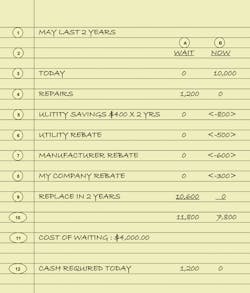The 'Cost of Waiting' Close, Part 2
FOR PART 1, CLICK HERE
PART 2:
You’ve followed the entire replacement sales procedure, quoted the price, and attempted to close the sale. The customer says, “Thank you for your time, but I think I’d like to put this off for now and get it done in the future.”
Your response is, “How long would you like to wait?” They’ll usually say they’d like to wait a year or two.
You ask, “Would you wait two years if you knew it was going to cost you over $3,000 to do so?”
They’ll usually say something like, “You can’t tell me it’s going to go up in price by $3,000 in one year!”
Now is when you start writing on your pad. You go straight to Line 3 in Figure 1. I say, “If you replace it today, you spend $10,000,” writing 10,000 in Column A. If you wait a couple of years, you spend nothing today,” and put a zero in Column B. Which side looks better to you?”
They tend to say, “The side with a zero in it. That’s what I’m trying to tell you.”
I’ll look at it all concerned and say, “Hmm, I must be doing something wrong. Let’s take a closer look at it. Well, if you’re going to run it for two years, you’re going to have to put some money into it,” and I’ll write down the cost of the repairs anticipated over the next two years as illustrated in on Line 4 of Figure 1. (We would have already gone over the numerous problems with their system and the approximate costs to repair them as part of the sales process to help establish the need and the sense of urgency, so this is a relatively quick part of the conversation.) I’ll add, “Since you’ve got new equipment that’s still under warranty, we can put a zero here,” and I’ll put a zero in Column B.
“Okay, you’ve got the utility savings,” I’ll say. If you don’t replace your equipment now, you aren’t charged anything extra, you just don’t see any savings, so I’ll put a zero here (in Column A of Line 5).” I’ll then write down two year’s worth of utility savings in Column B.
I then go over any rebates available, and write them down. In the mean time, as we’re talking, I’ll go ahead and write Lines 1 & 2 down on the piece of paper.
Then I say, “The very reasonable price of the system today is $10,000. Your guess is as good as mine. How much do you think something made out of copper, aluminum, steel, and plastic, that costs $10,000 today, will cost in two years?” and write that number down in Column A of Line 9, putting a zero in Column B. It’s very important that you get a number from the prospect. It’s okay if they think the price will only go up a few percentage points.
I then do the math and write “Cost of Waiting” and the totals on Line 11. I say, “Looks like I was wrong. It’s more than $3,000.”
Close #1:
“So, if we take the difference between replacing it now versus waiting, we get $____.
“Let’s see, if I divide that into your initial investment, we get ___%. Some people would call that a “tax-free return on investment.” Hmmm. That’s pretty good. Mr. and Mrs. (_________), would you consider that an acceptable return on investment?”
As a rule, they’ll say yes, and you can just extend your hand for a handshake and congratulate them on making a wise decision.
There are two more closes you can use with this technique, and I’ll cover them for you next month.
Charlie Greer is the creator of the audio book that makes the definitive statement on HVAC sales, “Slacker’s Guide to HVAC Sales”. This technique, and many others, is included on it. For details, call 1-800-963-HVAC, or visit hvacprofitboosters.com. Email you comments on this column and your sales questions to [email protected].

